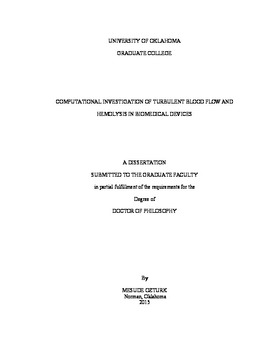| dc.description.abstract | Turbulent blood flow in medical devices contributes to blood trauma, yet the exact mechanism(s) have not been fully elucidated. Local turbulent stresses, viscous stresses, and the rate of dissipation of the turbulent kinetic energy have been proffered as hypotheses to describe and predict blood damage.
In this work, simulations of experiments in a Couette flow viscometer, a capillary tube, and a jet were used to examine extensive properties of the turbulent flow field and to investigate contributing factors for red blood cell hemoglobin release in turbulence by eddy analysis. Moreover, flows in a Couette viscometer and a capillary tube were simulated to investigate the impact of Reynolds and viscous stresses on hemolysis prediction using computations. Also, the applicability of four different hemolysis power law models for the capillary tube flow was tested as a function of area averaged and time averaged Reynolds stresses, viscous, total, and wall shear stresses. Finally, the size of Kolmogorov scale eddies was used to define a turbulent flow extensive property, and a new hemolysis model was proposed. This empirical model can work well with devices that exhibit different exposure times and flow conditions.
It was found that hemolysis occurred when dissipative eddies were comparable in size to the red blood cells. The Kolmogorov length scale was used to quantify the size of smaller turbulent eddies, indicating correspondence of hemolysis with number and surface area of eddies smaller than about 10 m. There was no evidence of a threshold value for hemolysis in terms of Reynolds and viscous stresses. Therefore, Reynolds and viscous stresses are not good predictors of hemolysis. In the case of power law models, area averaged Reynolds stress with the Zhang power law model gave the smallest error. | en_US |
